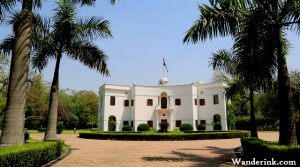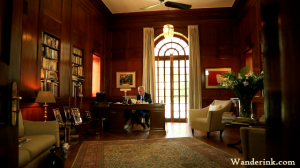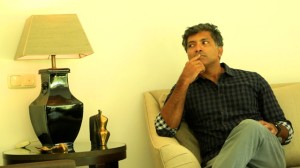Compared to its Mumbai namesake Jinnah House in Delhi has shunned controversy and sits quietly away from public glare, behind man-high baroque iron gates in the middle of an expansive, well groomed lawn. The guards are armed and unseen, stepping out of their watchhouse only as your car approaches. They look surprised to hear that you have indeed come to ‘10, Aurangzeb Road;’ since the recent renaming to ‘APJ Abdul Kalam Road’ which appears only at intersections most pop by to ask where it is. A flurry of calls followed by a thorough check of the car boot and an innocuous scrutiny of faces, we are directed to park in a recess next to a garage. A day time auxiliary appears holding a cordless phone and ushers us in through a side door. The Ambassador is on the way, we are informed, meanwhile, feel free to look around.
The man
Named after its most famous resident, Muhammad Ali Jinnah lived here from 1938 to 1947 with his sister Fatima; his estranged second wife Ratanbai Petit Jinnah (Ruttie) had died in 1929. He was 39 years old when he met the Parsi Ruttie who was 16; due to social pressures they waited for two years, Ruttie converted to Islam and took the name Mariam, before they got married and promptly ostracised from family circles. Sarojini Naidu who was in love with Jinnah wrote then, probably not very kindly: ‘So Jinnah has at last plucked the Blue Flower of his desire. The child has made far bigger sacrifices than she yet realises.’ They had a daughter Dina but Ruttie was soon to be disillusioned by Jinnah’s endless meetings and his lack of interest in music, arts and dance. Dina, mother of Nusli Wadia, Bombay Dyeing chairman, would later triangulate the India-Pakistan spat over the Jinnah House in Mumbai. The action witnessed by the one in Delhi shaped the destiny of two nations. It was in the wood panelled library here the final decision to divide the nation was arrived at.
The history
The All India Muslim League passed a resolution for a separate homeland for the Muslims of India at the Minto Park (Iqbal Park today) in Lahore on March 23, 1940. Following this, Jinnah began to travel to Delhi more often to discuss the finer details of Partition with other leaders like Sardar Vallabhai Patel, Jawaharlal Nehru, Rajendra Prasad and Gandhi. While he stayed at the Imperial Hotel during his first few visits, his friends like Liaquat Ali Khan who later became the first prime minister of Pakistan convinced him to have a more permanent arrangement here. The house on 10, Aurangzeb Road was originally built by FB Blomfied for Sardar Baisakha Singh a government contractor. It is said that Blomfied himself loved the house so much that he decided to stay there for some years on rent. Jinnah considered several properties around Delhi and finally the dapper politician settled for Singh’s stylish mansion at the intersection of Aurangzeb Road and Queensway (now Janpath). The price was three lakh rupees. The extravagant housewarming party was the talking point in social circles for years to come.
Many more lavish parties followed – most of which were to organise Muslims for the Pakistan cause. When Jinnah was not in town, Altaf Hussain, close friend and editor of the Muslim League organ The Dawn, acted as caretaker. Hussain also moonlighted as a caustic polemicist writing speeches for Jinnah. Once the Partition was finalised in 1947 and Jinnah was about to leave for Pakistan, he sold the house to Ramkrishna Dalmia, who owned the Times of India. Dalmia first rented out the house to the Dutch Ambassador. Eventually when he got wind of the government’s plan to requisition the property Dalmia pre-empted the demarche by selling it to the Dutch government. It has been the residence of Dutch Ambassadors since. We were here to interview the current one, the 17th since 1947, Alphonsus Stoelinga, for a film on Indo-Dutch trade relations.
The architecture
The foundation stone of the Jinnah House was laid by Lutyens, architect of modern Delhi, in March 1920; the house was designed and built by Blomfied. For nearly a century now the building remains true to its original form. A handsome habitation, some even regard this as the ‘most beautiful house in Delhi.’ Though I am not sure about this I can vouch that next to this the Antilla is a soaring Lego mishmash. Well, why just next to it!
My gaze followed the camera as it tilted down the spotless white facade. The mansion stood elegant with its own sense of scale and proportion, spread over two storeys. The Dutch national flag was hoisted in front of a small shiny dome at the top. The top floor opened to an open balcony with an arch and two column buttresses. Two longer ones flanked the main entrance which faced a freshly watered lawn glinting under a harsh sun. Small vertical windows stood out in contrast with their timber panes. Palm trees dotted the gardenscape, every ticket of leaf spotless green. Inside there were galleries, living rooms, bedrooms and a dining room. The famous library with its lush woodwork set off sybaritic burgundy overtones in the harsh afternoon sun mellowed by the curtains. It was the Ambassador’s study – as were of the others before him. Books were neatly stacked all around me in cavernous racks. Closer to the study was one on Rembrandt which looked suspiciously new.
“I thought Jinnah was not exactly an art savant,” I remarked to the Ambassador.
“Well, that is mine,” he replied not even looking up from the cutaway working shot we were now filming. He told me later that the entire library was his. Apparently all Ambassadors travelled with their own university-size libraries. I remember contracting catalepsy once when informed of the excess baggage fine I had to cough up because of dozen-odd books.
An outstanding feature of the interior design, which I took a while to notice, was the hexagonal shaped central hall with the ground floor radiating around it. The lobby resembled different roads that led to an intersection – just like how a city map of Delhi would look like.
Blomfied and Lutyens were more than friends – they were associates too.















Nicely. Including the film. Am thinking, next destination Idukki 🙂
Thank you. You should Idukki, a some – shall recommend duly as and when you are up for Kerala next. 🙂
Fascinating gem of a house, err piece. Seriously, interesting set of info. Wish there were more pics though.
Sure it is, Pragya. I didn’t really think about stills as was caught up with the job on hand. What you see here are mostly screen grabs from the ambassador interview.
I was to write my pending stories this time but had bookmarked this one since noon and now completely lost in this never heard before story behind 10, Aurangzeb Road. Another brilliant piece from your mighty pen.
Thank you, Alka. You still owe me beer. AND the Younghusband. HAHAHA.